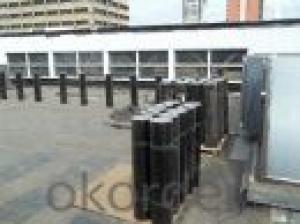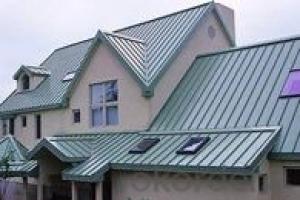SBS APP Modified Bitumen Waterproof Membrane With Good Quality
- Loading Port:
- Shanghai
- Payment Terms:
- TT OR LC
- Min Order Qty:
- 1000 m²
- Supply Capability:
- 200000 m²/month
OKorder Service Pledge
OKorder Financial Service
You Might Also Like
Product description
SBS Waterproof Material Self Adhesive Aluminium Membrane is produced with SBS elastomer and bitumen as raw materials, using polyethylene film.
Aluminium foil coated on the upward or no file(both side self-adhesive) while self-adhesive protection layer on the downward
surface.It has a widely prospect new contruction waterproof materials. Good self-adhesion, no leaking,cold flexibility,especially
in self-adhesion. That is unque product in waterproof and application.
Packaging & Shipping
Package and transportation-- SBS waterproof membrane / APP waterproof membrane / Asphalt waterproof membrane for building waterproofing construction :
1. Torch on bitumen membrane sheets 4mm should be stored under dry and ventilated conditions.
2. Different types of membranes must be piled separately.
3. Under usual condition, storage period is one year since production date.
4. Membrane roll should be put vertically during transportation. It should be kept away from sunshine and rainwater.
.
Advantagee
1.Good impermeability
2.Possess good tensile strength, elongation and size stability which could be well suited the substrate distortion and crack.
3.Good performance in anti-strength, anti-resistance , anti-erosion, anti-mildew, anti-weathering
4.SBS modified bitumen membrane is specially being applied in the cold area with low temperature, while APP modified bitumen membrane is applied in the area with high temperature.
5.Convenient installation
Applicable
1) Widely used in the industrial and civil building roofing, underground, pool, tunnel, wooden and metal roofing.
2) Specially applied in the oil depot chemical factory, garment factory, and granary.
3) Especially used in cold places.
4) Tape used for sealing all construction material surfaces.
Storage:
Different types or specifications of products should be separated, not mixed.
Keep it dry and ventilated, protected from the sun or rain.
Storage temperature should never be higher than 45 °C. Pile up the membranes flatwise whose stockpile height never exceeds five layers. One layer is guaranteed if it is placed vertically.
Prevent it from inclination or In the process of transportation, it should be lying in case of inclination or lateral pressure. If necessary, cover it with felt-cloth.
Storage time is at least one year from manufacture date on if the product is under normal operation of storage.
Technical Parameters
Item | Index | ||||||
1 | Thickness of resin layer of the middle fabric ,mm≥ | - | - | 0.40 | 0.40 | 0.40 | |
2 | Tensile performance | Max tensile strength,N/cm ≥ | - | 120 | 250 | - | 120 |
Tensile strength,NPa ≥ | 10 | - | -10 | - | - | ||
Max elongation% ≥ | - | - | 15 | - | - | ||
Breaking elongation % ≥ | 200 | 150 | - | 200 | 100 | ||
3 | Heat treatment size change rate%≤ | 2.0 | 1.0 | 0.5 | 0.1 | 0.1 | |
4 | Cold bonding | -25°c No cracks | |||||
5 | Watertightness | 0.3mPa,2h waterproof | |||||
product show
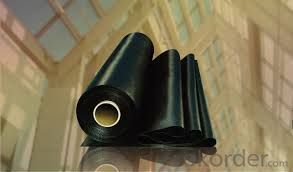
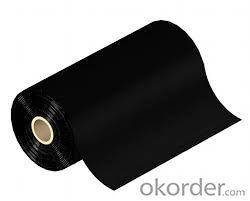
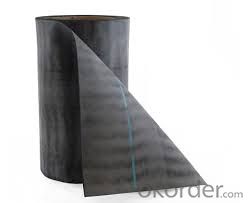
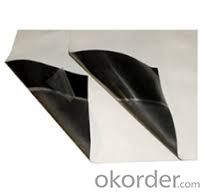




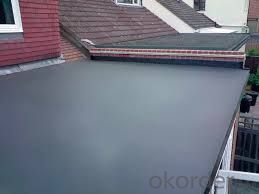
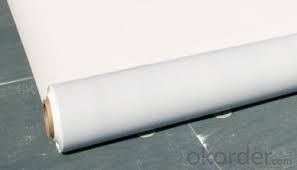
FAQ
Q: What's the de6abf1fe186f8d58506cbcfe46eed814d.jpglivery time ?
A: 3-5 days for 1-600 rolls, 10-15 days for container.
Q: What's the payment terms ?
A: TT/LC
Q: How do you make replacement with quality problems ?
A: New replacement will be packed into your next order or send to you directly after receive video or photo about quality problems.
- Q:How does a waterproofing membrane handle settlement or movement of the substrate?
- A waterproofing membrane is designed to accommodate settlement or movement of the substrate by possessing flexibility and elasticity. It can stretch or contract to a certain extent without losing its integrity or allowing water penetration. This ability allows the membrane to adapt to any changes in the substrate, ensuring long-term waterproofing performance.
- Q:Are waterproofing membranes suitable for stadium structures?
- Waterproofing membranes are well-suited for stadium structures. Stadiums are exposed to different weather conditions, such as rain, snow, and humidity, which can potentially harm the structure if proper waterproofing measures are not taken. By providing a protective layer that prevents water infiltration, waterproofing membranes safeguard the stadium from moisture-related problems like leaks, mold, and corrosion. Water accumulation on large roof areas and expansive seating areas is common in stadium structures, making waterproofing essential. Membranes can be applied on various surfaces, such as concrete, metal, and wood, offering a versatile and effective waterproofing solution for stadiums. Furthermore, waterproofing membranes offer durability and longevity, which is crucial for stadiums that experience heavy usage and constant exposure to the elements. They are designed to withstand thermal expansion and contraction, as well as UV radiation, ensuring long-term protection for the structure. Moreover, architects and engineers can customize waterproofing membranes to meet specific design requirements, seamlessly integrating them into the stadium's overall aesthetic. These membranes come in various colors, textures, and finishes, allowing them to blend with the surrounding materials and enhance the stadium's visual appeal. In conclusion, waterproofing membranes are a reliable and effective solution for protecting stadium structures from water damage. They provide durability, versatility, and customization options, making them suitable for any stadium construction or renovation project.
- Q:Can a waterproofing membrane be used on precast cement board surfaces?
- Yes, a waterproofing membrane can be used on precast cement board surfaces. Precast cement board surfaces are commonly used in construction, especially for exterior applications. These surfaces are not inherently waterproof, so applying a waterproofing membrane can provide an extra layer of protection against water infiltration. A waterproofing membrane is a thin layer of material that is applied to the surface of the cement board. It forms a barrier that prevents water from penetrating the board and reaching the underlying structure. This is particularly important for areas that are exposed to moisture, such as bathrooms, kitchens, and outdoor installations. There are different types of waterproofing membranes available, including liquid-applied membranes and sheet membranes. Liquid-applied membranes are typically rolled or sprayed onto the surface, while sheet membranes are applied like a sticker. Both types provide an effective waterproofing solution for precast cement board surfaces. When choosing a waterproofing membrane for precast cement board surfaces, it is essential to consider the specific requirements and conditions of the project. Factors such as the level of water exposure, climate, and intended use of the surface should be taken into account. It is also important to follow the manufacturer's instructions for application, as proper installation is crucial for the effectiveness of the membrane. In conclusion, a waterproofing membrane can be used on precast cement board surfaces to provide additional protection against water infiltration. It is a wise choice for areas that are exposed to moisture and can help prolong the lifespan of the cement board and prevent damage to the underlying structure.
- Q:Can a waterproofing membrane be used for pond or pool applications?
- Yes, a waterproofing membrane can be used for pond or pool applications. These membranes are specifically designed to create a water-tight barrier, making them suitable for preventing leaks and ensuring the structural integrity of ponds and pools.
- Q:Are waterproofing membranes UV resistant?
- Indeed, the majority of waterproofing membranes boast UV resistance. Given their frequent exposure to sunlight, UV resistance is a crucial attribute for these membranes. Over time, the degradation and deterioration caused by UV rays can significantly impair the effectiveness and durability of materials, necessitating the inclusion of UV-resistant additives or coatings by manufacturers. This incorporation of UV resistance safeguards the integrity and performance of the membrane, guaranteeing enduring protection against water infiltration.
- Q:Can a waterproofing membrane be used in areas with high foot traffic?
- Yes, a waterproofing membrane can be used in areas with high foot traffic. Waterproofing membranes are designed to provide a protective barrier against water and moisture, making them suitable for various environments, including areas with heavy foot traffic. These membranes are commonly used in commercial buildings, such as shopping malls, hospitals, and office complexes, where foot traffic is frequent. However, it is important to choose the right type of waterproofing membrane that is specifically designed for high foot traffic areas. Some membranes are more durable and resistant to wear and tear, making them ideal for such environments. Additionally, proper installation and maintenance of the membrane are crucial to ensure its longevity and effectiveness in high foot traffic areas. Furthermore, it is worth considering the specific requirements of the area and consulting with professionals or manufacturers to determine the most suitable waterproofing membrane for the given conditions. Overall, with the right selection and proper installation, a waterproofing membrane can effectively protect areas with high foot traffic from water damage and ensure their longevity.
- Q:What are the proper installation techniques for a waterproofing membrane?
- To ensure effective and long-lasting protection against water infiltration, proper installation techniques for a waterproofing membrane involve a series of steps. Here are some guidelines: 1. Start by preparing the surface. It is crucial to have a clean and smooth substrate. Eliminate any loose debris, dirt, or previous coatings. Before moving forward, make sure to repair any cracks or imperfections in the surface. 2. Enhance adhesion between the substrate and the waterproofing membrane by applying a suitable primer. The primer should be compatible with both the substrate material and the membrane. 3. Select a waterproofing membrane that suits the specific application and site conditions. There are different types available, such as sheet membranes, liquid-applied membranes, and self-adhesive membranes. Consider factors like the substrate material, expected movement or stress, and exposure to chemicals or UV radiation. 4. Install the membrane. The exact method may depend on the type of membrane used, but the following general steps apply to most installations: a. Carefully unroll or unfold the membrane, avoiding wrinkles or folds. b. Position the membrane onto the primed surface, ensuring it extends beyond the desired waterproofed area. c. Firmly press the membrane onto the substrate using a roller or trowel, ensuring good contact and eliminating air pockets. d. Overlap the edges of adjacent membrane sheets or sections according to the manufacturer's instructions, typically around 2-3 inches. e. Seal the overlaps securely by applying a suitable seam or joint adhesive. 5. Perform testing and inspection. After installation, it is essential to conduct a comprehensive quality control check. Conduct a flood or water test to verify the membrane's effectiveness in repelling water and to identify any leaks or defects. 6. Protect and finish the installed membrane. Prevent damage during construction activities and enhance durability and resistance to UV radiation or mechanical stress by applying necessary protection layers or coatings. 7. Maintain and repair. Regularly inspect the waterproofing membrane and promptly address any signs of damage, wear, or deterioration. Follow the manufacturer's guidelines for maintenance and perform necessary repairs as soon as possible to maintain the membrane's effectiveness. It is always advisable to consult with a professional waterproofing contractor or follow manufacturer recommendations for the specific membrane being used, as installation techniques can vary.
- Q:Can a waterproofing membrane be used in below-grade applications?
- Yes, a waterproofing membrane can be used in below-grade applications. Waterproofing membranes are often used in construction to prevent water penetration and leakage in below-grade areas such as basements or foundations. These membranes create a barrier that keeps water out, helping to protect the structure from water damage and moisture-related issues.
- Q:Can a waterproofing membrane be used in stadiums or sports complexes?
- Yes, a waterproofing membrane can certainly be used in stadiums or sports complexes. In fact, it is highly recommended to use waterproofing solutions in these types of structures to protect them from water damage and leakage. A waterproofing membrane acts as a barrier, preventing water from seeping into the concrete or other materials used in the construction of the stadium or sports complex. This is particularly important in areas where heavy rainfall or high humidity is common. By applying a waterproofing membrane to the roofs, walls, and foundations of these structures, it helps to ensure the integrity and longevity of the building, while also providing a comfortable and safe environment for athletes and spectators alike. Waterproofing membranes are designed to withstand the stresses and movements associated with the building, making them an ideal solution for stadiums and sports complexes. Additionally, modern waterproofing membranes are available in various forms, such as liquid-applied or sheet membranes, allowing for flexibility in application and compatibility with different construction materials.
- Q:Can a waterproofing membrane be used in conjunction with sustainable construction materials?
- Yes, a waterproofing membrane can be used in conjunction with sustainable construction materials. Sustainable construction materials such as recycled content, low VOC (Volatile Organic Compound) products, and green building materials are increasingly being used in building projects to reduce environmental impact. Using a waterproofing membrane in combination with sustainable materials helps ensure the longevity and durability of the structure while also maintaining its eco-friendly attributes.
1. Manufacturer Overview |
|
|---|---|
| Location | |
| Year Established | |
| Annual Output Value | |
| Main Markets | |
| Company Certifications | |
2. Manufacturer Certificates |
|
|---|---|
| a) Certification Name | |
| Range | |
| Reference | |
| Validity Period | |
3. Manufacturer Capability |
|
|---|---|
| a)Trade Capacity | |
| Nearest Port | |
| Export Percentage | |
| No.of Employees in Trade Department | |
| Language Spoken: | |
| b)Factory Information | |
| Factory Size: | |
| No. of Production Lines | |
| Contract Manufacturing | |
| Product Price Range | |
Send your message to us
SBS APP Modified Bitumen Waterproof Membrane With Good Quality
- Loading Port:
- Shanghai
- Payment Terms:
- TT OR LC
- Min Order Qty:
- 1000 m²
- Supply Capability:
- 200000 m²/month
OKorder Service Pledge
OKorder Financial Service
Similar products
New products
Hot products
Hot Searches
Related keywords


